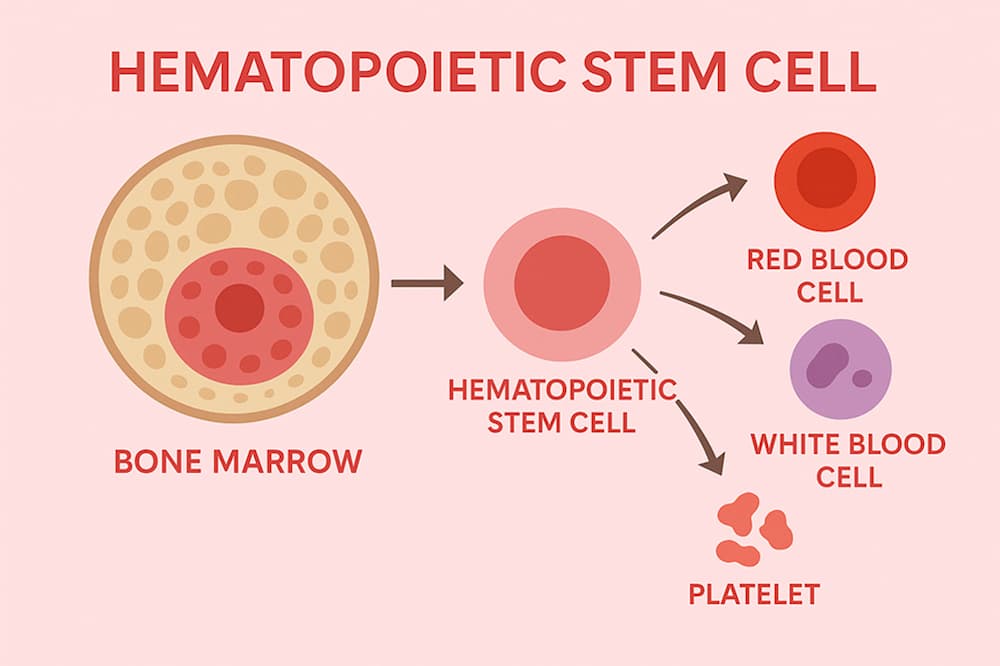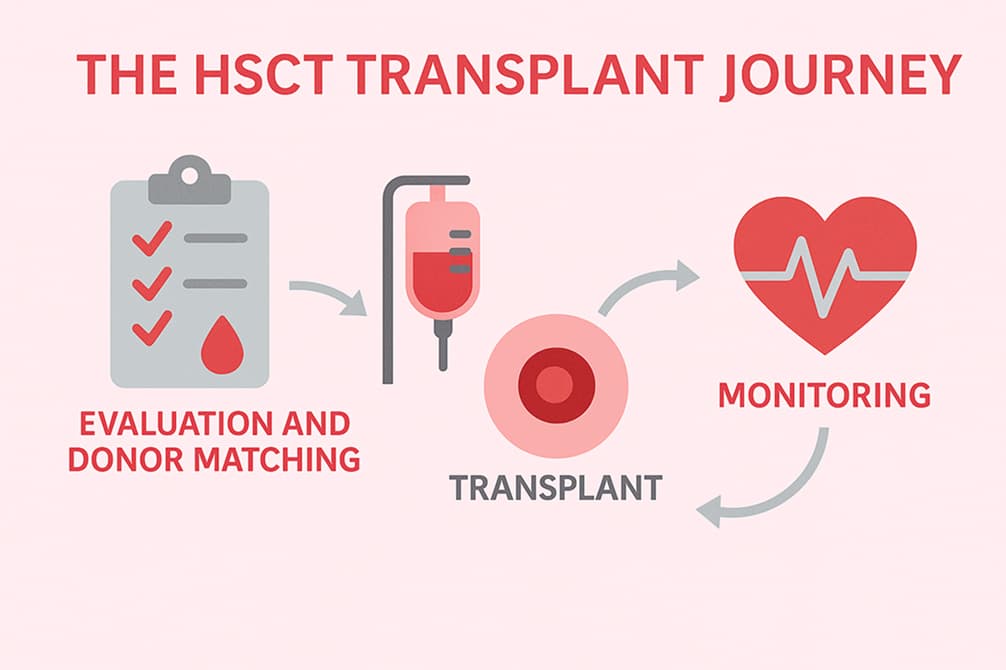Die hämatopoetische Stammzelltransplantation (HSCT) ist ein hochmodernes medizinisches Verfahren, das Patienten mit chronischen, lebensbedrohlichen Erkrankungen neue Hoffnung gibt. Bei diesem fortschrittlichen Ansatz wird geschädigtes körpereigenes Knochenmarkgewebe durch gesunde hämatopoetische Stammzellen (HSC) ersetzt, die sich zu neuen Blut- und Immunzellen entwickeln können.
Das therapeutische Potenzial von Stammzellen ist über das experimentelle Stadium hinaus gereift. Diese Transplantation stellt heute eine klinisch erprobte Behandlung mit vielversprechenden Ergebnissen dar. Das HSCT-Verfahren ist jedoch auch mit erheblicher medizinischer Komplexität und potenziellen Risiken verbunden, weshalb eine sorgfältige Bewertung und Überwachung wesentliche Bestandteile des Behandlungsprozesses sind.
Was ist eine hämatopoetische Stammzelltransplantation?
Die HSCT ist ein medizinisches Verfahren, das darauf abzielt, das blutbildende System des Körpers wiederherzustellen. Der Begriff „hämatopoetisch“ bezieht sich auf den Prozess der Bildung neuer Blutzellen – die Hämatopoese, die im Knochenmark stattfindet.

Sie werden in der Regel aus patienteneigenem Knochenmark oder Blut, Spenderknochenmark oder -blut oder aus Nabelschnurblut gewonnen. Nach der Entnahme werden sie bei der HSCT-Behandlung eingesetzt, um dem Körper bei der Regeneration von gesundem Gewebe zu helfen.
Warum HSCT lebensrettend sein kann
Der Blutkreislauf und das Immunsystem sind die zentralen Abwehr- und Unterstützungsnetzwerke des Körpers.
Ohne gesunde Blutzellen heilen Wunden nicht. Auch werden Infektionen nicht abgewehrt oder Gewebe mit Sauerstoff versorgt. Bei Krebserkrankungen wie Leukämie befallen bösartige Zellen das Knochenmark, während der Körper sich bei Immunerkrankungen wie Multipler Sklerose selbst angreift.
Eine HSCT-Therapie fördert nicht nur die Linderung der Symptome, sondern bietet eine Möglichkeit, diese Systeme von Grund auf neu aufzubauen. Durch den Ersatz von funktionsgestörtem Knochenmark durch gesunde Stammzellen können Patienten die Fähigkeit zur Produktion gesunder Zellen wiedererlangen. Dies führt oft zu einer langfristigen Remission oder sogar zur Heilung, wenn andere Behandlungen nicht wirksam sind.
Vorteile der hämatopoetischen Stammzelltransplantation
- Wiederaufbau des Immunsystems
- Zerstörung von krebsartigen oder fehlerhaften Zellen
- Hoffnung auf Besserung, wenn andere Behandlungen versagen
Interessieren Sie sich für Stammzelltherapie? Erfahren Sie mehr über die Arten von Stammzellen, die wir bei Swiss Medica verwenden, und wie sie unsere regenerativen Behandlungen unterstützen.
Artikel lesenMit HSCT behandelbare Erkrankungen
HSCT-Behandlungen werden bei einer Reihe von chronischen Erkrankungen eingesetzt, von denen viele einst als unheilbar galten. Nachfolgend sind die wichtigsten Bereiche aufgeführt, in denen diese Therapie das Leben von Patienten und Familien verändert hat.
Multiple Sklerose (MS)
Die hämatopoetische Stammzelltransplantation bei MS ist in Kombination mit einer Chemotherapie ein wichtiger Ansatz zur Behandlung dieser Erkrankung.
Studien bestätigen die Wirksamkeit dieser Methode und zeigen vielversprechende Ergebnisse bei der Aufhaltung des Krankheitsverlaufs und der Rücksetzung des Immunsystems. Patienten bemerken häufig Verbesserungen ihrer Fähigkeit, den Alltag zu bewältigen, sowie ihrer kognitiven Fähigkeiten und Beweglichkeit. Der Ansatz gibt insbesondere in den früheren, entzündlichen Stadien der MS Hoffnung.
Kostenlose Online-Beratung
Wenn eine Ihnen nahestehende Person von Multipler Sklerose betroffen ist, hilft unser Team Ihnen gern. Wenden Sie sich an einen unserer Experten für regenerative Medizin, um mehr über die verfügbaren Behandlungsmöglichkeiten zu erfahren.

Medizinische Beraterin, Ärztin bei Swiss Medica
Andere Erkrankungen
Über die Multiple Sklerose hinaus wird der Einsatz HSCT auch bei verschiedenen anderen chronischen Erkrankungen wissenschaftlich erforscht. Die Therapie kann beispielsweise bei der Behandlung von Blutkrebsarten wie Lymphomen wirksam sein. In einigen Fällen, insbesondere bei aggressiven oder rezidivierenden Formen, kann sie die Gesamtprognose verbessern.
Angeborene Immunstörungen sind ein weiteres Anwendungsgebiet, in dem die HSCT Hoffnung bietet. Es hat sich gezeigt, dass eine HSCT-Behandlung die Funktion des Immunsystems verbessert, indem sie den Patienten mit gesunden Vorläuferzellen versorgt. Dieser Effekt führt vor allem bei Personen, die durch häufige Infektionen lebensbedrohliche Komplikationen erleiden könnten, zu einer Verbesserung der Lebensqualität.
Bei seltenen Stoffwechselerkrankungen wie bestimmten Enzymmängeln wurde die Transplantation von hämatopoetischen Stammzellen ebenfalls untersucht. Dabei soll sie fehlende Stoffwechselfunktionen wiederherstellen. Die Einführung gesunder Stammzellen kann helfen, spezifische biochemische Ungleichgewichte zu korrigieren und das Fortschreiten der Erbkrankheit möglicherweise zu verlangsamen.
Arten von HSCT: Was ist der Unterschied?
Es gibt zwei Arten von Stammzellen, die bei der HSCT-Therapie verwendet werden: die eigenen Stammzellen des Patienten (autolog) und Stammzellen eines Spenders (allogen). Jede Art hat unterschiedliche Merkmale, die beeinflussen, welche Auswirkungen die Behandlung hat und für welche Patientengruppen sie am besten geeignet ist.
Autologe Transplantation
Bei dieser Art werden die Stammzellen des Patienten verwendet. Dieser Ansatz vermeidet Immunkomplikationen, da die körpereigenen Immunzellen verwendet werden. Er wird hauptsächlich angewendet, wenn der Zustand des Patienten die Verwendung seiner eigenen gesunden Zellen erlaubt.
Allogene Transplantation
Bei dieser Methode werden Stammzellen von einer anderen Person verwendet, in der Regel von einem passenden Spender. Der Hauptvorteil besteht darin, dass die Erkrankung des Patienten mithilfe gesunder HSC des Spenders bekämpft werden kann. Diese Art der Transplantation birgt jedoch das Risiko immunbedingter Komplikationen.
Transplantation von Nabelschnurblut
Bei dieser Methode werden Stammzellen aus gespendetem Nabelschnurblut verwendet. Nabelschnurblut-Transplantationen können besonders für Kinder und Patienten mit seltenen Gewebetypen vorteilhaft sein. Die Genesung kann jedoch im Vergleich zu anderen Formen der HSCT länger dauern.
Haploidentische Transplantation
Bei dieser Option wird ein Spender verwendet, dessen Zellen nur zur Hälfte mit denen des Patienten übereinstimmen. Oft handelt es sich um einen Elternteil, ein Kind oder Geschwister. Diese Behandlung eröffnet Möglichkeiten für Patienten, für die kein Spender mit vollständiger Übereinstimmung gefunden werden kann. So wird die HSCT-Therapie für mehr Menschen zugänglich.
HSCT ist nicht die einzige Option. Swiss Medica verfügt über umfassende Erfahrung mit mesenchymalen Stammzellen (MSC) und bietet Patienten einen sicheren und wirksamen Ansatz für die regenerative Behandlung.
Artikel lesenHSCT im Vergleich zur Therapie mit mesenchymalen Stammzellen
| Hämatopoetische Stammzellen (HSC) | Hämatopoetische Stammzellen (HSC) | |
| Präkonditionierung (Chemotherapie) | vor der Transplantation in der Regel Chemo-Konditionierung/Leukapherese erforderlich | keine Chemotherapie erforderlich |
| Therapiekosten | hoch – teure Verfahren und Spendersuche | niedriger – weniger ressourcenintensive Verfahren |
| Spenderkompatibilität (MHC-Moleküle) | strikte HLA-Übereinstimmung erforderlich – exprimierte MHC Typ I/II | minimale HLA-Übereinstimmung erforderlich – geringe MHC-Expression |
| Zellquelle | Knochenmark | Knochenmark, Fettgewebe, Nabelschnur- und Plazentagewebe |
| Komplikationsrisiko | Transplantatabstoßung, Graft-versus-Host-Reaktion | gering – MSC besitzen geringe Immunogenität |
Die Therapie mit mesenchymalen Stammzellen ist eine der charakteristischen Behandlungsmethoden von Swiss Medica. Sie kann die Gehirnfunktion unterstützen, Entzündungen lindern und das Fortschreiten von Krankheiten verlangsamen. Neugierig, wie sie funktioniert?
Mehr über MSC-Therapie erfahrenDer Transplantationsprozess
Der Weg zur HSCT besteht aus mehreren sorgfältig koordinierten Phasen, von denen jede für den Gesamterfolg der Behandlung entscheidend ist.
Der Prozess beginnt mit einer gründlichen medizinischen Untersuchung und gegebenenfalls der Suche nach einem geeigneten Spender. Darauf folgt das Transplantationsverfahren, dem je nach Zustand des Patienten eine Konditionierungstherapie vorausgehen kann.
Nach der Stammzelltransplantation werden die Patienten genau überwacht, um sicherzustellen, dass sich die eingeführten hämatopoetischen Stammzellen etablieren und die richtige Wirkung entfalten.

Wie Spender gefunden und ausgewählt werden
Bei allogenen HSC-Transplantationen werden Spenderstammzellen, die eine hohe HLA-Expressionsstärke aufweisen, in den Körper des Empfängers eingebracht.
Den richtigen Spender für eine HSCT zu finden, ist entscheidend für den Erfolg des Eingriffs. Spezialisten konzentrieren sich vor allem auf die Übereinstimmung der humanen Leukozyten-Antigene (HLA), die wichtige Immunsystem-Marker auf der Zelloberfläche sind. Diese Marker spielen eine zentrale Rolle dabei, wie das Immunsystem die patienteneigenen Zellen erkennt.
Eine enge HLA-Übereinstimmung zwischen Spender und Empfänger senkt das Risiko von Immunkomplikationen wie der Graft-versus-Host-Reaktion (GvHR) erheblich und verbessert die Transplantationsergebnisse. Deshalb sind eine sorgfältige HLA-Typisierung und -Abstimmung wesentliche Schritte im Spenderauswahlprozess.
Mögliche Nebenwirkungen und Komplikationen
Eine sorgfältige Abstimmung von Spender und Empfänger ist unerlässlich, um das Risiko einer Immunabstoßung zu verringern. Um dieses Risiko weiter zu minimieren, müssen sich die Patienten außerdem einer immunsuppressiven Therapie unterziehen.
Trotz dieser Vorsichtsmaßnahmen können jedoch mehrere schwerwiegende Komplikationen auftreten:
- Graft-versus-Host-Reaktion (GvHR): eine Immunreaktion, bei der die transplantierten Zellen das Gewebe des Empfängers angreifen
- Infektionen: Da das Immunsystem während und nach der Transplantation geschwächt ist, sind die Patienten sehr anfällig für Infektionen.
- Leber- und Nierenfunktionsstörungen: Eine starke immunsuppressive Therapie oder Bestrahlung vor der Transplantation kann die Organe schädigen.
- Rückfallrisiko: In einigen Fällen kann die Krankheit auch nach einer erfolgreichen Transplantation zurückkehren.
Deshalb ist die Auswahl eines erfahrenen, vertrauenswürdigen HSCT-Behandlungszentrums entscheidend, um das bestmögliche Ergebnis zu gewährleisten.
Kostenlose Online-Beratung
Bei Swiss Medica sind wir stets bestrebt, die Wirksamkeit unserer Therapie zu maximieren, und bieten daher sicherere Behandlungsoptionen an. Kontaktieren Sie uns, um mehr zu erfahren.

Medizinische Beraterin, Ärztin bei Swiss Medica
Faktoren, die die Ergebnisse der HSCT beeinflussen
| Alter | Junge Patienten genesen oft besser, während ältere Patienten mit mehr Komplikationen konfrontiert sein können. |
| Allgemeiner Gesundheitszustand | Patienten, die vor der Transplantation in einem guten Allgemeinzustand sind, haben tendenziell höhere Erfolgsraten und weniger Komplikationen. |
| Art und Stadium der Erkrankung | Die Behandlung wirkt in der Regel besser bei weniger aggressiven Erkrankungen in einem frühen Stadium. |
| Zellquelle | Die Wahl zwischen autologen und allogenen Zellen kann die Ergebnisse je nach Art der Erkrankung beeinflussen. |
Ernährung und Immununterstützung nach der Transplantation
Die Genesung endet nicht mit der HSCT selbst. Sie erfordert mehr als nur Zeit, nämlich einen umfassenden Fokus auf den Wiederaufbau des Immunsystems, die Aufrechterhaltung der richtigen Ernährung und die Wiedererlangung der körperlichen Stärke. Mit einem maßgeschneiderten Genesungsplan, der körperliche Rehabilitation, Infektionsprävention und Ernährungsunterstützung umfasst, können Patienten ihre Lebensqualität schneller und sicherer zurückgewinnen.
Häufig gestellte Fragen
Wie funktioniert die hämatopoetische Stammzelltransplantation?
Das HSCT-Verfahren ersetzt geschädigtes Knochenmark durch gesunde hämatopoetische Stammzellen. Dies hilft dem Körper, wieder normale Blut- und Immunzellen zu produzieren.
Was kostet eine HSCT-Behandlung?
Die Kosten für eine hämatopoetische Stammzelltransplantation hängen vom Land, der Zellquelle und der Dauer des Krankenhausaufenthalts ab. Viele Patienten prüfen daher Kosten für eine HSCT im Ausland, insbesondere in HSCT-Zentren in Europa.
Welche Schritte umfasst das Verfahren der hämatopoetischen Stammzelltransplantation?
Der HSCT-Prozess umfasst die Bewertung, die Spendersuche, die Konditionierung, die Transplantation und die Genesung. Jeder Schritt wird von erfahrenen medizinischen Teams sorgfältig geplant.
Kontaktieren Sie uns
Benötigen Sie Beratung zu fortschrittlichen medizinischen Behandlungsmöglichkeiten?
Füllen Sie einfach das kurze Antragsformular unten aus. Einer unserer Spezialisten wird Sie kontaktieren, um eine persönliche, kostenlose Beratung zu vereinbaren.

Medizinische Beraterin, Ärztin bei Swiss Medica
Quellenangaben:
Khaddour K, Hana CK, Mewawalla P. Hematopoietic Stem Cell Transplantation. [Updated 2023 May 6]. In: StatPearls [Internet]. Treasure Island (FL): StatPearls Publishing; 2025 Jan-. Verfügbar unter: https://www.ncbi.nlm.nih.gov/books/NBK536951/
Malgorzata Mikulska, Francesca Gualandi, Paola Anserini, Chapter 10 – Early and late complications of hematopoietic stem cell transplantation, Editor(s): Matilde Inglese, Giovanni L. Mancardi, Handbook of Clinical Neurology, 2024, https://doi.org/10.1016/B978-0-323-90242-7.00010-9.
Tan EY, Boelens JJ, Jones SA, Wynn RF. Hematopoietic Stem Cell Transplantation in Inborn Errors of Metabolism. Front Pediatr. 2019 Oct 25;7:433. doi: 10.3389/fped.2019.00433. PMID: 31709204; PMCID: PMC6824291.
Burns SO, Morris EC. How I use allogeneic HSCT for adults with inborn errors of immunity. Blood. 2021 Nov 4;138(18):1666-1676. doi: 10.1182/blood.2020008187. PMID: 34077952.
Morita-Fujita M, Arai Y, Yoshioka S, Ishikawa T, Kanda J, Kondo T, Akasaka T, Ueda Y, Imada K, Moriguchi T, Yago K, Kitano T, Yonezawa A, Nohgawa M, Takaori-Kondo A; Kyoto Stem Cell Transplantation Group (KSCTG). Indication and benefit of upfront hematopoietic stem cell transplantation for T-cell lymphoblastic lymphoma in the era of ALL-type induction therapies. Sci Rep. 2020 Dec 8;10(1):21418. doi: 10.1038/s41598-020-78334-x. PMID: 33293600; PMCID: PMC7722931.
Sailor, K.A., Agoranos, G., López-Manzaneda, S. et al. Hematopoietic stem cell transplantation chemotherapy causes microglia senescence and peripheral macrophage engraftment in the brain. Nat Med 28, 517–527 (2022). https://doi.org/10.1038/s41591-022-01691-9